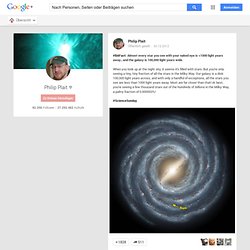

Sean Goebel Photography: Timelapse. Philip Plait - Google+ - #BAFact: Almost every star you see with your naked eye is… +Jacobo Blanco No, I understand science just fine.

My first time starting college was when I was 12, I attended until funding for the program ran out. I'm also a certified genius. So, let's keep the smug responses to a minimum, okay? See, +josh stodghill is right. Science HAS become a religion, and people believe nearly anything a group of scientists say, with very little to no evidence. I never spoke in favor of religion, by the way. In fact, you can't establish a fact based strongly upon stacks of theories; it would simply be bad science. Best astronomy images 2012: See the most beautiful images of the universe. The Universe is beautiful.

Which is interesting. It doesn’t have to be; it could be all colorless and weird and lumpy. Instead, it’s bursting with color, sculpted by vast forces, molded into fantastic shapes that please our eyes and delight our brains—especially once we understand what we’re seeing. Every December I pick my favorite images from the previous year to display, a task that is extraordinarily difficult. I always wind up with a list of about 60 or 70, and I have to cull it down mercilessly. Many of these, you might expect, are from Hubble, but other telescopes get their share, as well as some that were taken by amateur astronomers with not much more than good cameras and a desire to see and capture the Universe. I can’t argue with that sentiment. On Aug. 31, 2012, the Sun had a major hissy fit: A vast arch of material was lifted up off the surface by the Sun’s powerful magnetic field.
JAXA/NASA/Lockheed Martin. The Best Vacation Photo Ever. City Lights 2012 - Flat map. Acquired April 18 - October 23, 2012download large image (776 KB, JPEG, 3600x1800)

NOAA Satellite Reveals New Views of Earth at Night. NASA hunts gravitational waves on atomic level - Technology & science - Space. Albert Einstein predicted the existence of gravitational waves that ripple outward from moving celestial objects such as stars or black holes — but such waves are so weak by the time they reach Earth that the planet quivers by less than an atom's width in response. NASA wants to harness the spooky quantum behavior of atoms to help detect the gravitational waves. The U.S. space agency has funded the possible solution, called atom interferometry, so that it might someday enable a mission consisting of three identical spacecraft flying in a triangle formation between 310 miles and 3,107 miles.
If a gravitational wave swept through the area, the spacecraft interferometers would sense the tiny disturbances. "The NASA funding is basically for a preliminary design study for what a gravitational wave detector would look like," said Mark Kasevich, a physicist at Stanford University. A stunning star factory for Hubble’s 22nd! April 24th marks the 22nd anniversary of Hubble’s launch into space.

To celebrate it, NASA and ESA released this devastating panoramic view (also available here) of the mighty star-forming region 30 Doradus: Yegads. [Click to embiggen, or get the 4000 x 3200 pixel version, or grab the ginormous 267 Mb 20,323 x 16,259 pixel version. There's also a way cool zoomable image too.] 30 Dor is a vast, sprawling, and chaotic region located in the Large Magellanic Cloud, a dwarf irregular galaxy that orbits our Milky Way. In fact, those young stars are so luminous and energetic they’re eating away the cloud from the inside out! In fact, the folks at Chandra released a similar version of this image, except they added observations from that observatory, which detects X-rays (as well as an image using Spitzer which sees in infrared).
In the big Hubble image, I think my favorite part is the pinkish-orange circle located just left of center (it’s easier to see in the bigger versions of the pictures). My Galaxies. Video - Breaking News Videos from CNN.com. How deep the Universe. The Universe is a big place.

I mean, really big. Big enough for anything. Literally, big enough for everything. Everything you see, everywhere you go, it’s all inside. And there’s room for all of it, with space to spare. Let me show you something: [Click to galactinate, and while it may take a little while to download the entire 3500 x 2000 pixel image, it will definitely be worth your time.] This is the nearby spiral galaxy NGC 1345 as seen by Hubble. Now there you go. Look. But even if it’s only a thousand light years away, that’s 10 quadrillion kilometers!
… and that star is the closest thing in that picture. "Nearby. " But now let your eyes roam over the image. And in the course of things, this was a short exposure for Hubble, just a little over half an hour. And yet the Universe is deeper even than that.